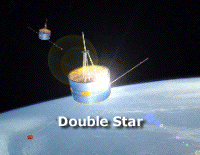The first Sino-European satellite completes its mission
16 October 2007
In the early morning on 14 October, the Double Star TC-1 satellite, the first scientific spacecraft built and operated by the Chinese National Space Administration (CNSA) in cooperation with the European Space Agency (ESA), returned to Earth after completing its designed orbit lifetime. Operated together with its twin TC-2 and the four satellites of the ESA Cluster mission, TC-1 has been a highly successful scientific mission. It re-entered the Earth's atmosphere and disintegrated during its descent.
 |
|
Double Star and science highlights |
Science Highlights
The four years of the DSP mission have brought many new perspectives concerning the boundaries of the magnetosphere and the fundamental processes that are playing a role in the transport of mass, momentum and energy into the magnetosphere. For the first time, the evolution of structures and physical processes were observed at small scales within the Cluster tetrahedron, and then at large scales with Double Star.
A large number of papers have appeared in the literature since the Double Star launches. A special issue of Annales Geophysicae on the first Double Star results was published in November 2005. A special issue of the Journal of Geophysical Research on the latest results of Double Star and Cluster is under review and will be published in the coming months. Since most of Double Star papers are associated with Cluster data, all papers are combined in a single list. As of September 2007, this list contains 978 papers, among which 683 are refereed papers.
Science results where TC-1 played a crucial role include:
1. Earh's bow shock vicinity
-
Space is Fizzy: Density Holes Found in the Solar Wind.
Ion density holes were discovered near the Earth's bow shock that can play a role in bow shock formation. The bow shock is a critical region of space where the constant stream of solar material, the solar wind, is decelerated from supersonic speed to subsonic speed due to the internal magnetic field of the Earth.
Full story: http://sci.esa.int/jump.cfm?oid=39559
Echo of this story on CNN:
http://www.cnn.com/2006/TECH/space/06/20/space.bubbles/index.html
2. Inner magnetosphere and energetic particles
-
Chorus Emissions Found Further Away From Earth During High Geomagnetic Activity.
Chorus are waves naturally generated in space close to the magnetic equator, within the Earth's magnetic bubble called magnetosphere. These waves play an important role in the creation of relativistic electrons and their precipitation from the Earth's radiation belts. These so called killer electrons can damage solar panels and electronic equipments of satellites and represent a hazard to astronauts. Therefore, information on their location with respect to the geomagnetic activity is of crucial importance to be able to forecast their impact.
Chorus sound file: http://sci.esa.int/science-e/www/object/doc.cfm?fobjectid=38339
3. Magnetotail dynamics
-
Cluster and Double Star Reveal the Extent of Neutral Sheet Oscillations.
For the first time, neutral sheet oscillations observed simultaneously at a distance of tens of thousands of kilometres are reported, thanks to observations by 5 satellites of the Cluster and the Double Star Program missions. This observational first provides further constraint to model this large-scale phenomenon in the magnetotail.
Full story: http://sci.esa.int/jump.cfm?oid=38999
"The TC-1 satellite has demonstrated the mutual benefit of, and has fostered, scientific cooperation in space research between China and Europe. We expect even more results when the final archive of high resolution data will be made available to the worldwide scientific community", underlines Philippe Escoubet, Double Star and Cluster project scientist of the European Space Agency.
Contact
Web story author
Arnaud Masson, SCI-OS division, ESA, The Netherlands
E-mail: Arnaud.Masson esa.int
esa.int
Phone: +31-71-565-5634
Web story editors
Philippe Escoubet, SCI-SM division, ESA, The Netherlands
E-mail: Philippe.Escoubet esa.int
esa.int
Phone: +31-71-565-4564
Arnaud Masson, SCI-OS division, ESA, The Netherlands
E-mail: Arnaud.Masson esa.int
esa.int
Phone: +31-71-565-5634
Matt Taylor, SCI-OS division, ESA, The Netherlands
E-mail: Matthew.Taylor esa.int
esa.int
Phone: +31-71-565-8009
Professor Z.X. Liu, State Key Laboratory for Space Weather, Center for Space Science and Applied Research (CSSAR), Chinese Academy of Sciences, Beijing 100080, China
E-mail: liu cssar.ac.cn
cssar.ac.cn
Professor J. Wu, State Key Laboratory for Space Weather, Center for Space Science and Applied Research (CSSAR), Chinese Academy of Sciences, Beijing 100080, China
E-mail: wuji cssar.ac.cn
cssar.ac.cn
Note to editors
ESA contributed to the construction/refurbishment and pre-integration of eight European instruments, and was so far acquiring data for 4 hours per day using the VILSPA-2 ground station near Madrid, Spain. ESA also coordinated the scientific operations for the European instruments, via ESTEC in Noordwijk, the Netherlands and the European Payload and Operations Service (EPOS) at Rutherford Appleton Laboratory, United Kingdom. China's contribution included the two spacecraft buses, eight other scientific experiments, and the launches. China conducted the spacecraft and Chinese instruments operations. After a nominal mission of one year (from the launch of TC-2 in July 2004), the Double Star mission was extended twice by both agencies till the end of September 2007.
